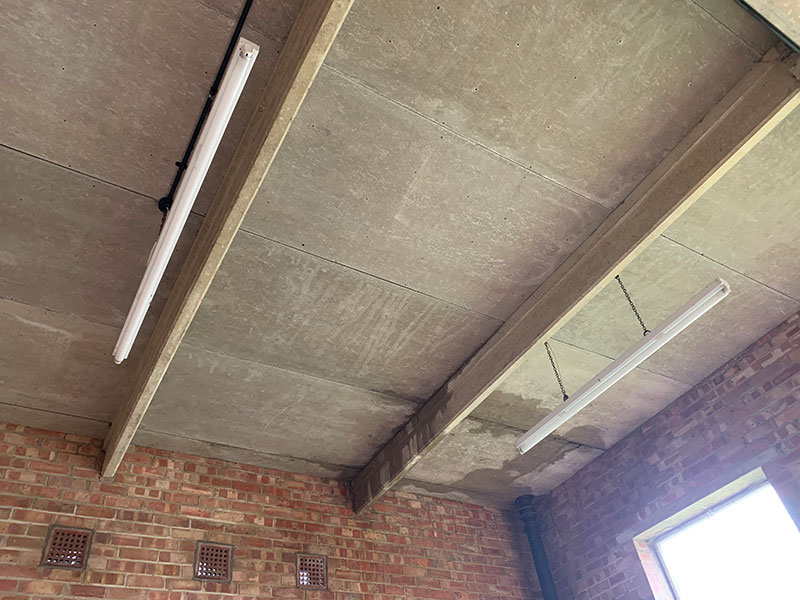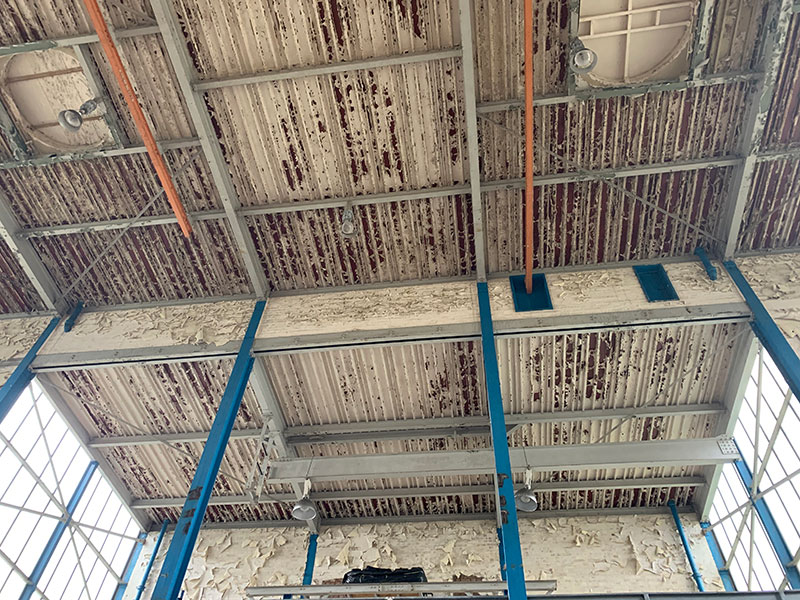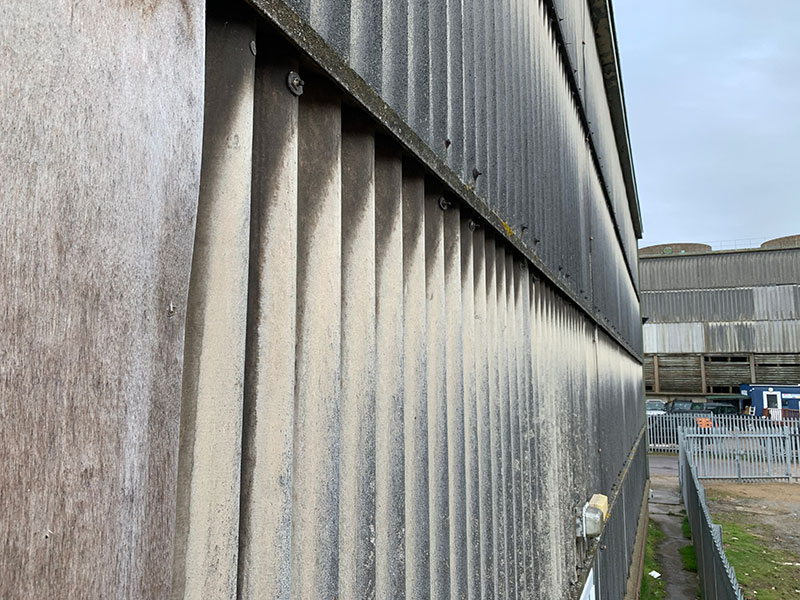How do I check for asbestos in cement?
Eventually, the true dangers of asbestos became known. While cement is no longer combined with asbestos, many older structures still contain asbestos cement.
Asbestos cement can be present in all different areas of a building, both inside and outside. Generally, it’s found where year-round insulation from moisture and extreme temperatures is important. That’s why it’s common to have asbestos cement in garages and roofing.
The state of the cement determines how dangerous it is to work with. Non-licensed workers may be able to handle cement that’s in good condition. Cement that’s likely to break, though, or that’s already damaged requires a specialist.
What is asbestos cement?
Asbestos cement is a hard, durable building material made by mixing asbestos fibres, usually chrysotile (white asbestos), with cement. It was commonly used in roofing sheets, pipes, flue liners, and wall panels. Asbestos typically makes up 10% to 15% of the mixture. While most products used white asbestos, some also contained blue (crocidolite) or brown (amosite) fibres. All types of asbestos are hazardous, and asbestos cement can release fibres when cut, drilled, or weathered.
What does asbestos cement look like?
Asbestos can come in all sorts of finishes and products. Often, asbestos cement is light or dark gray. Otherwise, it looks much like traditional cement, as that’s what makes up most of the mixture.
Sometimes, when you inspect cement closely, you can actually see the white asbestos that’s mixed in. While you can’t always see the white asbestos in cement, a white-and-gray look can be a sign that the cement does include asbestos.
Some asbestos cement products have a distinct look, too. For example, asbestos cement roofing usually has a wavy design. We have an asbestos cement gallery where you can see the different types of products that may contain asbestos.
Where is asbestos cement commonly found?
Asbestos cement was widely used in construction before its ban. The most common places you might find asbestos cement include:
- Corrugated roofing sheets (especially garages and sheds)
- Guttering and downpipes
- Water tanks and cold water cisterns
- Wall and ceiling panels
- Soffits and fascia boards
- Flue pipes and chimney linings
- Door and cupboard linings
The material was appealing to builders because of its strength and ability to resist moisture.
As you can see, nearly all areas of a building can have asbestos cement. It tends to be more common on the exterior of a building than the interior.
Let’s talk about a few asbestos cement products in more detail.
Cement flues
Air conditioning, boiler systems, and ventilation systems sometimes have flues made with asbestos cement.
Cement roofs
Asbestos cement in roofing is commonly found on farmyard or industrial buildings. It may also be in garage or shed roofing. The roofing will look like large sheets of corrugated cement.
Asbestos cement roofing may have natural growths on the sheets, like moss. That’s a sign that the roofing’s been there for several years. These growths can also cause the cement to deteriorate more quickly.
Removal of the cement may not be necessary if it’s still in good condition. It is a good idea to clear the roof, though, as long as you can clear the growth without damaging the cement.
Downpipes and gutters
Asbestos-containing downpipes and gutters are typically found in warehouse buildings and will be attached at the end of cement roofing.
Drainage pipes
Pitch fibre was commonly used to make sewage and water pipes. Since pitch fibre is lightweight, the addition of asbestos cement would strengthen it.
Wall cladding
Asbestos wall cladding appears similar in structure to cement roofing. It’s found on the walls of buildings that also have asbestos cement in the roofing.
Is asbestos cement dangerous?
Asbestos is dangerous if it becomes damaged and its microscopic fibres release. Inhaling those fibres can cause major health conditions far in the future. Sometimes, the effects of long-term asbestos exposure don’t show up for 40 or more years.
Asbestos cement is hazardous as it ages because it becomes brittle. Breakage and debris mean those harmful fibres release and inhalation is possible.
What should you do if you suspect the presence of asbestos cement?
If you suspect that asbestos is present in cement, it’s best to contact a professional. A specialist can confirm that asbestos is present and let you know the next steps to take.
A cement analysis uses a water-absorption test to determine if asbestos is present in the cement. It can also detect if there’s another asbestos material present.
There are asbestos testing kits you can use yourself. When using them, it’s important to follow the instructions carefully and wear protective equipment. However, due to the hazardous nature of asbestos, we always recommend that you consult a professional asbestos testing company instead of attempting to test the suspect material yourself.
The business owner has a duty to manage asbestos
Business owners are legally required to manage asbestos on the premises. This means that the business owner must monitor the condition of the asbestos cement to reduce risk. If it’s breaking or in poor condition, the owner must arrange for its removal.
Do asbestos cement products have to be removed?
Undisturbed and undamaged asbestos products don’t pose a huge risk, and they don’t always require removal. Many cement products are durable and last for a long time, so removal isn’t always necessary.
That said, asbestos cement has a unique problem. Even if it’s currently in good shape, cement degrades. When this happens, asbestos fibres release into the air. If people nearby inhale them, that can cause serious health problems in the future.
Older asbestos cement products will need fixing or replacement at some point. When it’s time to do that, only an expert should handle the removal.
You may also want to have the cement removed and replaced before it causes a problem. With asbestos being so threatening to your health, it’s worth it to get ahead of the problem.
How should asbestos cement be removed?
It’s possible that a non-licensed member of your team can remove undamaged cement. In this case, it’s not necessary to notify the authorities. The HSE’s asbestos essentials page has directions for removing asbestos cement products. Directions include:
- Restricting access to the area while removal takes place
- Wearing a respirator in heavily contaminated areas
- Using a spray to dampen asbestos cement
- Disposing of large pieces of cement in an asbestos waste bag
- Carefully scooping or scraping up asbestos on rough surfaces
- Using damp rags to clean surfaces that were contaminated
- Picking up asbestos dust deposits with adhesive tape
- Proper disposal of the asbestos waste bag
Depending on the deterioration, though, notifying the authorities may be a requirement. That includes work that may result in major damage. For example, let’s say there’s asbestos cement in roofing. During removal, there’s a risk that the cement could drop and break apart. This high risk means that it’s a job for a licensed worker.
Another possible situation is that the cement is already badly damaged. This poses a high risk of exposure to hazardous fibres. A risk assessment will determine who can remove it. If in doubt, always consult a professional asbestos removal company for advice.
Keeping workers safe from asbestos exposure
Asbestos comes in many different forms. With so many cement products containing asbestos, err on the side of caution. Assume the cement you’re working with has asbestos and proceed carefully.
Proper asbestos testing can confirm if asbestos is present. From there, you can take steps to remove the cement while keeping everyone safe. Knowing where it might be present can defend you, your workers, and anyone in the building against exposure to it.
If you require assistance in identifying or removing asbestos, please contact the Oracle Solutions team today. We will be pleased to provide you with a free, fast, and competitive quote for any of our highly regarded asbestos management services.

Written by Jess Scott
Jess Scott has been an all-round asbestos consultant since 1996. That’s nearly 3 decades of asbestos knowledge. He spends his time sharing that knowledge with the team at Oracle and with their clients. Jess's goal is, and always has been, to use my expertise in helping people to comply with the law. This legal compliance ultimately helps to protect everyone from the harmful effects of asbestos. Jess has acted as an asbestos expert witness in legal cases and is involved in many asbestos educational activities throughout the UK.






